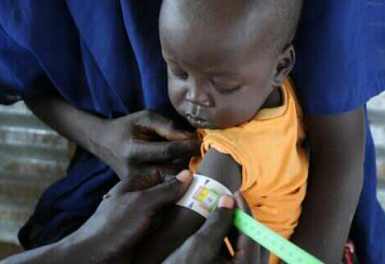Malnutrition rates still high in S. Sudan despite food security improvements
October 4, 2014 (JUBA) – Tens of thousands of children under the age of five remain at risk of malnutrition-related death in South Sudan, despite temporary improvements in the food security situation, a report from the Integrated Food Security Phase Classification (IPC) group of experts revealed.

“Diarrhoea and other illnesses prevent children from absorbing nutrients, so even where there is improved access to food, children can still be dangerously malnourished”, it added.
Those in conflict-affected areas, especially the 1.4 million people who are internally displaced, more than half of whom are children are reportedly the most at risk.
According to the United Nations Children Fund (UNICEF), malnutrition rates for children are at critical or serious levels in most parts of South Sudan. In some areas where large numbers of people displaced by the conflict have gathered, the rates of acute malnutrition for children are reportedly over 30 per cent – more than double the officially recognised emergency levels.
The situation has been worsened by the rainy season which has made it practically difficult to deliver to malnourished children the required humanitarian assistance.
“Thousands of malnourished children who have not yet been reached remain in peril,” said Jonathan Veitch, UNICEF Representative in South Sudan.
“We have to take advantage of the coming dry season – and passable roads – to preposition life-saving supplies for the treatment of children suffering from malnutrition. It is critical that we are able to accelerate our response during this window of opportunity”, he added.
The latest IPC analysis projects that 1.5 million people will be in “crisis and emergency food insecurity levels” from September through December, an improvement over the last projection, as the coming months represent the harvest season.
The IPC also credited humanitarian assistance for improvement in some areas.
The IPC further warned that the outlook for 2015 remains of great concern, with 2.5 million people at crisis or emergency levels from January to March.
An additional $25 million, UNICEF says, is urgently to enable it scale up its nutrition response and preposition life-saving nutrition supplies during the coming dry season.
(ST)
